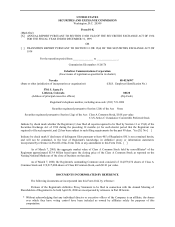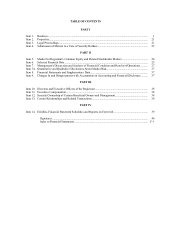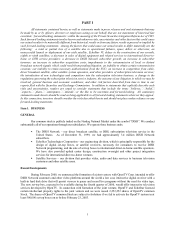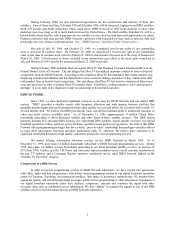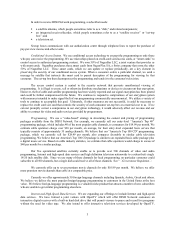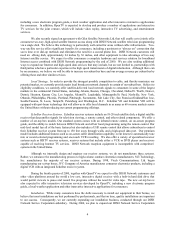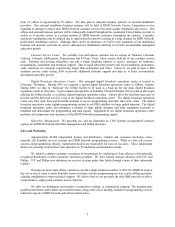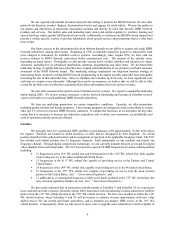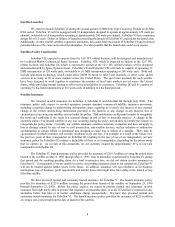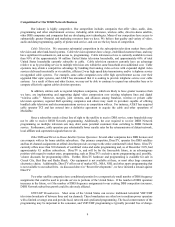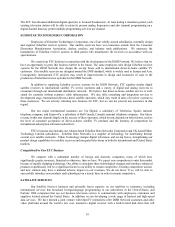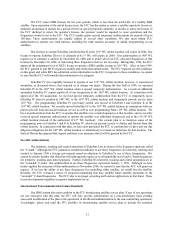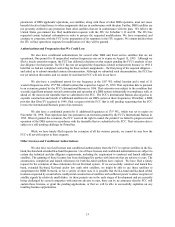Dish Network 1999 Annual Report Download - page 5
Download and view the complete annual report
Please find page 5 of the 1999 Dish Network annual report below. You can navigate through the pages in the report by either clicking on the pages listed below, or by using the keyword search tool below to find specific information within the annual report.3
In order to receive DISH Network programming, a subscriber needs:
• a satellite antenna, which people sometimes refer to as a “dish,” and related components;
• an integrated receiver/decoder, which people sometimes refer to as a “satellite receiver” or “set-top
box”; and
• a television set.
Set-top boxes communicate with our authorization center through telephone lines to report the purchase of
pay-per-view movies and other events.
Conditional Access System. We use conditional access technology to encrypt the programming so only those
who pay can receive the programming. We use microchips placed on credit-card sized access cards, or “smart cards” to
control access to authorized programming content. We own 50% of NagraStar LLC, a joint venture that provides us
with smart cards. NagraStar purchases these smart cards from Nagra Plus SA, a Swiss company that owns the other
50% of NagraStar LLC. These smart cards, which we can update or replace periodically, are a key element in
preserving the security of our conditional access system. When a consumer orders a particular channel, we send a
message by satellite that instructs the smart card to permit decryption of the programming for viewing by that
consumer. The set-top box then decompresses the programming and sends it to the consumer’s television.
The access control system is central to the security network that prevents unauthorized viewing of
programming. It is illegal to create, sell or otherwise distribute mechanisms or devices to circumvent that encryption.
However, theft of cable and satellite programming has been widely reported and our signal encryption has been pirated
and could be further compromised in the future. We continue to respond to compromises of our encryption system
with measures intended to make signal theft of our programming commercially uneconomical. We utilize a variety of
tools to continue to accomplish this goal. Ultimately, if other measures are not successful, it could be necessary to
replace the credit card size card that controls the security of each consumer set-top box at a material cost to us. If we
can not promptly correct a compromise in our encryption technology, it would adversely affect our revenue and our
ability to contract for video and audio services provided by programmers.
Programming. We use a “value-based” strategy in structuring the content and pricing of programming
packages available from the DISH Network. For example, we currently sell our entry-level “America’s Top 40”
programming package, which includes 40 of the most popular cable channels, to consumers for $19.99 per month. We
estimate cable operators charge over $30 per month, on average, for their entry-level expanded basic service that
typically consists of approximately 55 analog channels. We believe that our “America’s Top 100 CD” programming
package, which we currently sell for $28.99 per month, also compares favorably to similar cable television
programming. We believe that our America’s Top 100 CD package is similar to an expanded basic cable package plus
a digital music service. Based on cable industry statistics, we estimate that cable operators would charge in excess of
$40 per month for a similar package.
Our five operational satellites currently enable us to provide over 500 channels of video and audio
programming, Internet and high-speed data services and high definition television nationwide to a subscriber’s single
18-20 inch satellite dish. Since we use many of these channels for local programming, no particular consumer could
subscribe to all 500 channels, but a single dish could receive all of those channels. See “ – Government Regulation”.
We currently offer up to seven premium movie channels for only $10.99 per month. We believe we offer
more premium movie channels than cable at a comparable price.
Currently we offer approximately 50 foreign-language channels including Spanish, Arabic, Greek and others.
We believe we deliver the most popular foreign-language programming to customers in the United States at the best
value. We believe foreign-language programming is a valuable niche product that attracts a number of new subscribers
who are unable to get similar programming elsewhere.
Internet and High-Speed Data Services. We are expanding our offerings to include Internet and high-speed
data services. We have formed a joint venture with OpenTV which will offer DISH Network customers an
interactive digital receiver with a built-in hard disk drive that will permit viewers to pause and record live programs
without the need for video tape. We also intend to offer interactive television services developed by OpenTV,

